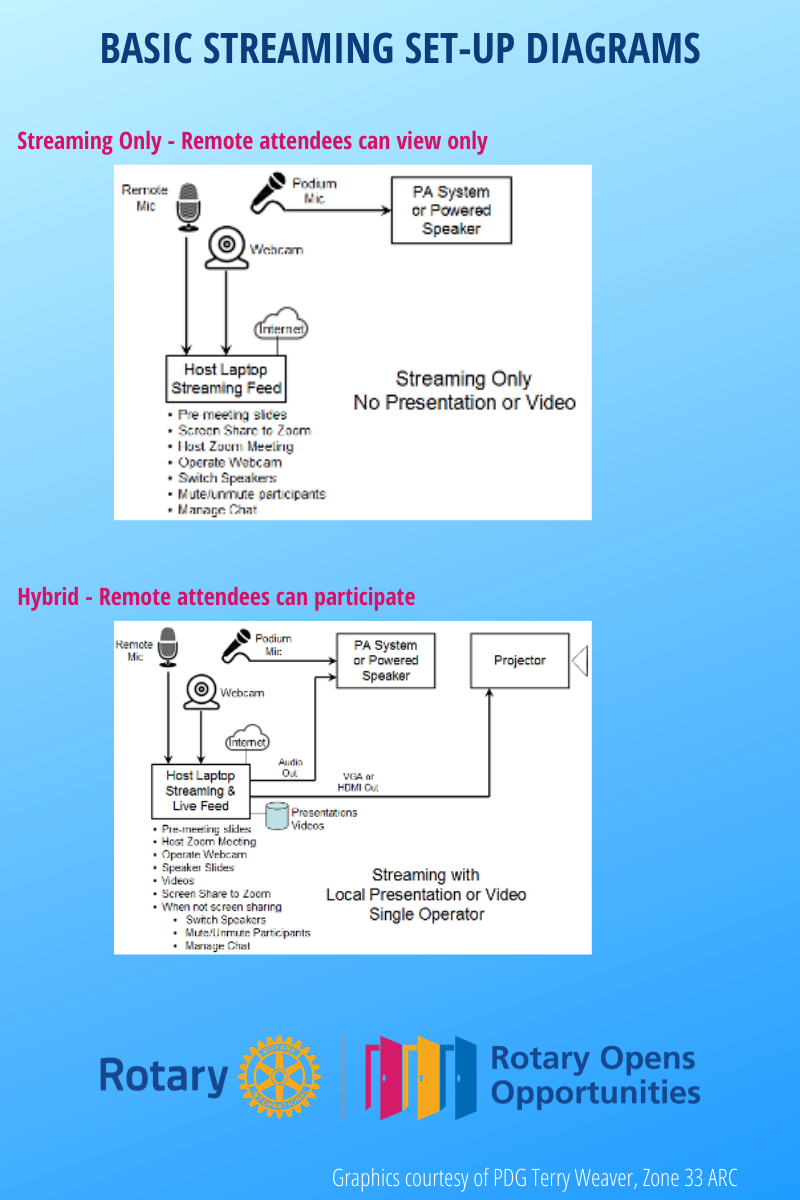
During the COVID crisis and pandemic many clubs have seen an increased level of engagement with members due to the introduction of video conferences and streaming.
As clubs begin a return to the new normal, the ability to still include a streaming option for those unable to attend meetings will add value to a member’s club experience. It will allow members, young and old, to participate in club meetings even if they are physically unable to attend for whatever reason.
Technology might even open up a new membership type for your club with virtual classifications. If anything, this could be an invaluable retention tool for those members teetering on the edge of leaving Rotary.
Let’s face it – the way we meet has changed dramatically. Many of us have recently turned to virtual collaboration tools like Zoom, Google Hangouts, etc. so that, even though we cannot be together in the same space, we can still share ideas and stay productive. But these tools don’t have to be alternatives, they can be supplemental. Online meetings are useful, productive, and make remote-collaboration possible, but fusing the benefits of the virtual with the physical will create an event that goes even further.
So, in the meantime, while it may be some time until all Rotarians are comfortable with attending "in-person" Rotary meetings like we have always had, clubs are considering alternative solutions that not only allow us to connect, but also, allow us to engage. Enter hybrid meetings… This type of meeting combines the benefits of in-person and virtual interactions so that each event can reach its highest potential.
What Is A Hybrid Meeting?
Hybrid meetings are meetings or events that feature at least one group of in-person / face-to-face attendees connecting virtually with other meeting attendees (that is, some members meet in person and others join virtually via real-time conferencing apps). While hybrid events have been around for a number of years, their importance will only grow during and following the COVID-19 pandemic. Hybrid Meetings combine the benefits of live and virtual interaction between presenters, in-person attendees, and virtual attendees.
Virtual And Hybrid Meetings – Why You Need A Separate Approach
The key difference between hybrid meetings and virtual meetings is this fusion between the live event and the virtual event creates different types of attendees. Our environment greatly affects our ability to stay focused. During an in-person meeting, the environment is specifically designed to communicate the message of the meeting and to keep people interested. But if an attendee is virtual, there is no control over their environment, and they may lose focus.
Sometimes, you have only got seconds to grab someone’s attention and only 10 minutes to keep it. At 9 minutes and 59 seconds, you must do something to regain attention and restart the clock — something emotional and relevant. These different attendee and meeting types require a custom solution and your overarching meeting goals will determine how the meeting will be designed.
Different Types Of Hybrid Meetings And Events
Hybrid meetings can span multiple spectrums of the in-person and virtual meeting realm. There are hybrid meetings that span from a split between a face-to-face audience and a virtual audience to only having presenters at the live event to in-person pods/breakouts that communicate in a virtual environment to a fully live audience with a virtual presenter.
Technology And Hybrid Meetings
One of the first questions about hybrid meetings is "what technology should be used"? The answer – don’t let technology define your meeting goals – define your goals first and then source and apply the best available technology to support it. Whether it’s working within existing technology solutions within your organization or integrating a new option, if you define the type of hybrid meetings first, the technology will be there to support it. In other words...Don’t put the cart in front of the horse.
Benefits Of Hybrid Meetings
Hybrid meetings should be an integral part of your risk management assessment for meetings following COVID-19.
- They allow participants who are unable or unwilling to attend a live event to do so virtually.
- Multiple types of hybrid meetings present multiple options for the planning team, depending on your goals
- Removes traditional confines and allows for a collaborative environment
- Hybrid meetings are a cost-effective option featuring the benefits of both face-to-face and virtual meetings
Hybrid meetings allow for both personal connections and connections that extend far beyond the physical confines of the event. With virtual meeting technology quickly progressing and becoming more reliable every day, hybrid meetings are becoming the new normal. By combining the benefits of a physical meeting with the benefits of a virtual meeting, you do not have to sacrifice powerful connections for greater outreach, you can have both.
The Hybrid Rotary Meetings Technology Guide compiled by PDG Terry Weaver, Rotary Zone 33 will save you countless hours of research and trial-and-error. Please invest the time to read through it and you'll be halfway to getting your Hybrid Meetings strategy launched.
